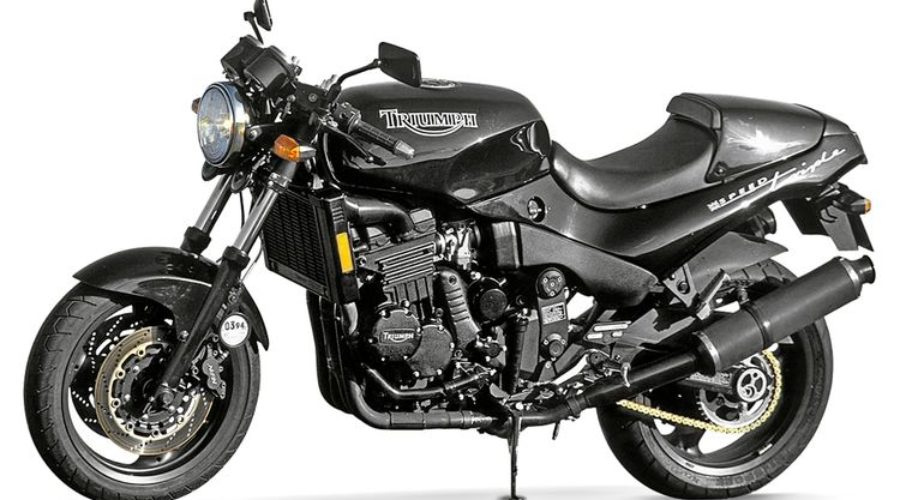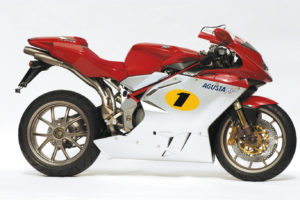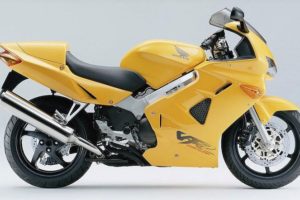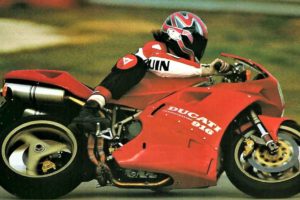1994 Triumph Speed Triple
Speed Triple. It’s a name which begged to be used at some stage. Whether this is the Triumph which deserves it or not is another matter. Perhaps some model more pivotal to the new Triumph factory’s future should be the heir to the name. The original Speed Twin was arguably the old firm’s single most significant model.
Edward Turner’s famous twin began in the 1930s what became Triumph’s trademark parallel twin history. The engine saw various bore and stroke dimensions, a change to unit construction (the engine and gearbox being built into one unit) and more but the roots were easy to trace back. The Speed Twin wrote Triumph’s post-war future. Pity it was left to go undeveloped into the mass grave of the British motorcycle industry.
But if you’re into looking back down family trees, it won’t be long until you realise the Speed Triple’s form is true to its name. With its impressive and beautiful styling, the new bike evokes the glorious past of that old twin and the twin’s heyday in the 1960s when the cafe racer ruled the roads. Black, lean, proportioned and purposeful, the Speed Triple is unquestionably a nostalgic styling exercise for a very modern motorcycle.

And God it’s styled well. There’s not an ugly side to it. From the compact grouping of the clip-ons, headlight and instruments right down to the curving tailpiece atop the up-swept carbon-fibre mufflers, the Speed Triple looks horny. It’s beauty goes deep into the black paint on the tank and bodywork. Its dash features tidy, whitefaced clocks with black markings that turn orange at night. Between the speedo and tacho are tiny but bright warning lights set in an alloy plate. Few other bikes I’ve tested have garnered so much enthusiastic comment about its looks. All its lines seem to blend smoothly. Nothing looks out of place. Perhaps most telling of all is the fact that it is one of those very rare naked motorcycles which looks fast even when it’s sitting still.

However, the Speed Triple isn’t really that quick. Sure, it’ll top 200 km/h and get there bloody quickly; it’d run rings around the old Tritons and Goldies it mirrors. But it is no hyper-sports motorcycle. Instead, the black Triumph has a mature approach to speed – the easy, loping gait made possible by that wonderful 900cc triple, with civilised but capable chassis performance backing it up.
The Speed Triple is essentially a 900 Daytona without the fairing, so when you climb into its tall seat you still have the long reach to lowish handlebars but there’s only those classy instruments in front of you. The bars-seat-footpeg arrangement curls you into a laidforward sports ride position but it is not uncomfortable except for the weight which rests on your wrists at speeds up to around 100-110km/h.

Moving bodyweight around the bike is not a hassle, albeit not always necessary either. One of the most striking things about the Speed Triple is that, without a fairing, the clip-ons seem quite narrow, although they’re still much wider than on original café racers.
The Triumph triple’s sound is unique. It is a deep rasp which matches perfectly the solid feel of the powerplant. By all accounts since the introduction of the 1990s Triumphs the engines are robust and well made. On the road, it is the 900 triple’s flat torque curve which is most meaningful, endowing the bike with a powerband as wide as you like. It’s matched to a five-speed gearbox instead of the Daytona’s six-speeder; the Speed Triple simply does away with the sixth gear cog in the otherwise identical box but it has a 43-tooth rear sprocket in place of the Daytona’s 46 tooth.

Geared as it is it shows about 112 km/h at 5000 rpm in top, it is well into the red at 220 km/h and it’ll pull wheelies on the power if you provoke them. Pretty much right for a naked sportster, I reckon. However, such are the power characteristics that you could go up or down in final ratio to suit your taste and the Speed Triple would lap it up.
For a spirited ride on a winding road I liked to keep the motor spinning above six grand, changing at around the 9500 rpm redline. This way you can use the meaty engine braking of the long-stroke motor, too. The gear changes are swift and very positive, with a bit of a clunk accompanying every shift.
There’s certainly not enough power to overwhelm the standard rear tyre, a 180-section Michelin Hi-Sport radial in the stickier A compound. This is Superbike traction here. The front tyre’s a B compound Hi-Sport.

However, this Speed Triple didn’t have the same on-rails poise of the 900 Daytona I rode a while back. Admittedly this particular bike, which was the press demonstrator before being bought by Ed Byrne of Tom Byrne Motorcycles, had some problems early on, like badly set fork internals in one leg. When I got it for testing, and once I’d set the suspension to where I liked it best, this bike still suffered some front-end vagueness in corners where I wasn’t prepared to commit myself hard. Because I’ve ridden an essentially identical Triumph which felt just right, I’ll risk saying this problem isn’t common.
On the other hand, though, my experience on various Triumphs indicates there’s some inexplicable handling differences between supposedly identical bikes, even between two Trident 900s, for example. Another gripe I have is that even the top-grade Triumphs get under-damped rear ends. It’s apparent most in mid-corner dips, when the back end feels like a big fat bum wobbling behind. It seems I invariably end up setting front and rear springs and rebound damping pretty firm and the front compression about mid-way to get Triumphs handling close to how I like them to and the Speed Triple didn’t change things.
Set up to suit, the Speed Triple rewarded me with some smooth cornering and surprising straight-line stability. Through any corner I knew and could see through, it felt great – not razor sharp, thanks to slow-ish steering, but confidence-inspiring and happy. This is the kind of sports bike which works with you, rather than egging you on to higher things all the time in the way race-replicas do.
Four-piston brakes on large discs slow the speeding triple rapidly, giving enough feedback to satisfy most riders. The triple doesn’t react too badly to being slowed mid-corner, either, unless you grab a big fistful of brakes and then no bike works particularly well. Brake firmly over grooves in the road, though, and the front tyre will do its best to follow them, whichever way they go.

Outright performance is not the Speed Triple’s reason for being, of course, and it starts, turns and stops at least as well as it needs to. Its real attraction is its class: its good looks and quality build. It’s got bucketloads of both. Sure, higher bars would be more practical. So would a fairing. Maybe a narrower rear tyre. No, no, no – that’s for other Triumphs. This one’s the Speed Triple and it is what it is: a pure styling job that cashes in on Triumph’s history and also shows off the marque’s future.
The real cafe racer has evolved into the GSX-Rs, ZXRs and YZFs of this world and I know which I’d back in a sprint race. When it comes to street cred, class and real world considerations, though, the Speed Triple’s charm and good looks will win the day anytime.
By Mick Matheson. Two Wheels, September 1994.


Guido from AllMoto owns a few Triumphs, including the very tasty Daytona 1200 he’s pictured on above. He has written extensively on the Speed Triple, including this piece on the history and collectability of all the three cylinder Triumphs since the T150 of the mid-1970s (here), plus a great yarn about the Speed Quattro (here), which is what you get when, for some misguided reason, you decide that what it really needs is a four cylinder engine.

Ian Falloon is one of the world’s foremost motorcycle historians and authorities on classic motorcycle provenance and authenticity. He has written many books on classic and collectable motorcycles, including two on Triumph: The Complete Book of Classic and Modern Triumph Motorcycles and Triumph Bonneville, 60 Years, both available here.




